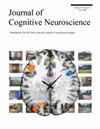Single-pulse Transcranial Magnetic Stimulation Affects Working-memory Performance via Posterior Beta-band Oscillations
IF 3.1
3区 医学
Q2 NEUROSCIENCES
引用次数: 0
Abstract
A single pulse of TMS (spTMS) during the delay period of a double serial retrocuing working-memory task can briefly rescue decodability of an unprioritized memory item (UMI). This physiological phenomenon, which is paralleled in behavior by involuntary retrieval of the UMI, is carried by the beta frequency band, implicating beta-band dynamics in priority coding in working memory. We decomposed EEG data from 12 participants performing double serial retrocuing with concurrent delivery of spTMS using Spatially distributed PhAse Coupling Extraction. This procedure decomposes the scalp-level signal into a set of discrete coupled oscillators, each with a component strength that can vary over time. The decomposition revealed a diversity of low-frequency components, a subset of them strengthening with the onset of the task, and the majority declining in strength across the trial, as well as within each delay period. Results with spTMS revealed no evidence that it works by activating previously “silent” sources; instead, it had the effect of modulating ongoing activity, specifically by exaggerating the within-delay decrease in strength of posterior beta components. Furthermore, the magnitude of the effect of spTMS on the loading strength of a posterior beta component correlated with the disruptive effect of spTMS on performance, a pattern also seen when analyses were restricted to trials with “UMI-lure” memory probes. Rather than reflecting the “activation” of a putatively “activity silent” UMI, these results implicate beta-band dynamics in a mechanism that distinguishes prioritized from unprioritized, and suggest that the effect of spTMS is to disrupt this code.单脉冲经颅磁刺激通过后贝塔波段振荡影响工作记忆能力
在双序列回溯工作记忆任务的延迟期内,单脉冲经颅磁刺激(spTMS)可短暂挽救未优先记忆项(UMI)的解码能力。这种生理现象在行为上与 UMI 的非自愿检索类似,由贝塔频段承载,表明贝塔频段动态与工作记忆中的优先级编码有关。我们使用空间分布式 PhAse 耦合提取法分解了 12 名参与者的脑电图数据,这些参与者在进行双序列回溯的同时接受了 spTMS 治疗。该方法将头皮级信号分解为一组离散的耦合振荡器,每个振荡器的分量强度会随时间变化。分解结果显示了低频成分的多样性,其中一部分随着任务的开始而增强,大部分在整个试验过程中以及在每个延迟期内强度下降。经颅磁刺激的结果显示,没有证据表明它是通过激活先前 "沉默 "的信号源而起作用的;相反,它具有调节持续活动的效果,特别是通过夸大后部贝塔成分在延时内强度的下降。此外,经颅磁刺激对后部贝塔成分加载强度的影响程度与经颅磁刺激对表现的破坏作用相关,当分析仅限于 "UMI-lure "记忆探针的试验时,也可以看到这种模式。与其说这些结果反映了 "活动沉默 "的 UMI 的 "激活",不如说这些结果将贝塔带动力学与区分优先与非优先的机制联系在一起,并表明经颅磁刺激的效果是破坏这一代码。
本文章由计算机程序翻译,如有差异,请以英文原文为准。
求助全文
约1分钟内获得全文
求助全文
来源期刊
CiteScore
5.30
自引率
3.10%
发文量
151
审稿时长
3-8 weeks
期刊介绍:
Journal of Cognitive Neuroscience investigates brain–behavior interaction and promotes lively interchange among the mind sciences.
文献相关原料
| 公司名称 | 产品信息 | 采购帮参考价格 |
|---|

 求助内容:
求助内容: 应助结果提醒方式:
应助结果提醒方式:


